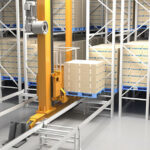The logistics industry is rapidly adopting automated solutions to optimise warehouse operations. Conveyor systems are one of the key technologies driving this transformation and enabling businesses to handle rising order volumes efficiently. Automated conveyor systems offer numerous benefits compared to manual material handling or non-automated conveyor solutions.
RELATED: Warehouse Conveyor Systems: Powering Up Your Logistics.
What are Conveyor Systems Used for in Warehouses?
Conveyor systems are the backbone of automated warehouses and distribution centres. They transport, sort, sequence, buffer, and transfer products and packages between various processes like receiving, storage, picking, packing, and shipping. Conveyor systems enable seamless workflows and high-throughput operations.
Some common applications of conveyor systems in warehouses include:
- Inbound conveyors for receiving and put-away
- Sortation systems to route products to storage locations
- Picking-line conveyors to present items for order fulfillment
- Outbound shipping conveyors to sequence and transport orders
- Pallet conveyors for moving pallets and heavy loads
- Vertical conveyors like lifts and spirals connect different facility levels
Benefits of Automated Conveyor Systems
Automated conveyor systems provide significant advantages over manual material handling:
- Increased throughput and processing speeds
- Consistent and reliable workflows are unaffected by labor availability
- Reduced product damage and improvements in accuracy
- Efficient use of space through optimised conveyor designs
- Savings on labor costs by reducing dependence on warehouse staff
- Ergonomic working environment with less physical strain
- Scalability to accommodate business growth and peak periods
Automated conveyor systems enable warehouse managers to meet rising consumer expectations for speed and accuracy while controlling fulfillment costs.
Types of Warehouse Conveyor Systems
Conveyor technologies are highly customisable with many types available
- Roller conveyors use gravity and motors to move products on wheels or rollers. They come in light, medium, and heavy-duty designs.
- Belt conveyors utilise rubber, fabric, or wire mesh belts running over pulleys to transport small to large sized materials.
- Chain conveyors feature powered chain drives to carry loads suspended from hooks, trays or pins. They work well for unusually shaped objects.
- Vertical conveyors like lifts and spiral chutes move items between facility levels. High-speed vertical conveyors have throughputs over 200 cases per minute.
- Sortation systems redirect products to determined destinations using pushers, pop-up wheels or movable arms. High-speed sorters can process over 500 items per minute with multi-level sorting possible.
- Pick-to-light systems provide visual pick indicators to operators. They are often integrated with conveyors for efficient order fulfillment.
Warehouse managers choose conveyor types based on load capacity, workflow speeds, levels of control, and facility layout.
Implementing Automated Conveyor Systems
Upgrading to automated conveyor systems involves:
- Assessing current workflows, bottlenecks and labor costs
- Evaluating throughput requirements and peak volumes
- Reviewing product characteristics like weight, dimensions, and fragility
- Developing a business case with costs and ROI
- Choosing the right conveyor technologies and control systems
- Integrating with existing warehouse infrastructure and software
- Installing and testing the conveyor equipment
- Training staff on safe operating procedures
- Monitoring performance and optimising as required
Leading conveyor system manufacturers have industry expertise to consult on system design, integration, installation, and optimisation. They utilise leading controls technologies and simulation software to model proposed solutions.
The Future of Warehouse Automation
Conveyor systems will continue playing a major role in warehouse automation.
Current trends include:
- Increasing implementation of zone routing systems which use autonomous vehicles or robots to transfer loads between conveyor sections as needed. This provides greater warehouse flexibility.
- Growth of high-density automated storage and retrieval systems (ASRS) with integrated conveyors for ultra-fast picking.
- More implementation of automated guided vehicles (AGVs) and autonomous mobile robots (AMRs) capable of transporting conveyor-ready totes and carts to pickers or stations.
- Advances in artificial intelligence to dynamically optimise conveyor systems and full warehouse workflows in real-time.
- Expansion of modular and scalable conveyor designs to accommodate seasonal fluctuations and omni-channel order profiles.
As consumer expectations and order volumes grow, automated conveyor systems enable modern warehouses to achieve the throughput, accuracy and responsiveness needed to stay competitive. Conveyors are a smart investment for optimising workflows now and providing flexibility for future expansion as operations evolve.
RELATED: Conveyor Systems: The Backbone of Efficient Material Handling.
FAQs on Warehouse Conveyor Automation
Q: How do conveyor systems connect with other warehouse automation technologies?
A: Conveyor systems integrate with automated storage and retrieval systems (ASRS), pick-to-light systems, warehouse management systems (WMS), automated guided vehicles (AGVs) and more. This enables seamless workflows optimised for efficiency.
Q: How are conveyor systems controlled?
A: Conveyors use programmable logic controllers (PLCs) and industrial PCs to handle sensors, switches, motors and actuators. Software visualises data flows and allows flexible reconfiguration.
Q: Can conveyor systems be implemented in phases?
A: Yes. Modular conveyor designs allow phased implementation by area or process. This reduces upfront costs while delivering ROI through early phases.
Q: How can conveyor systems improve order accuracy?
A: Automated barcode scanning, dimensioning systems and integrated weighing scales provide visibility and ensure only correct items are conveyed to fulfillment processes.
Q: How does conveyor automation reduce labor requirements?
A: Conveyors streamline material transport between processes. This reduces labor needed for transporting, sorting and locating items. It allows staff to focus on higher-value picking and packing activities.
Step into the future with SmartlogitecX, a WayZim Technologies venture, reshaping Warehouse Automation in Australia and New Zealand. Our mission is to provide you with advanced, efficient warehouse solutions that are a step ahead. SmartlogitecX combines global tech insights with local market expertise. Ready to upgrade your logistics? Our sales team is on hand to craft your ideal automation strategy.



